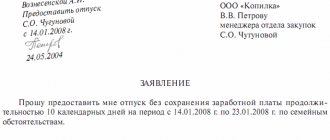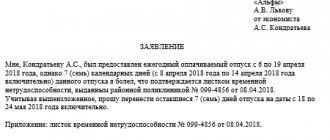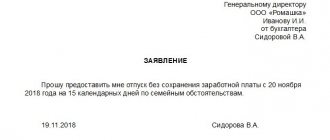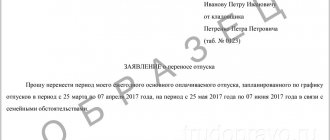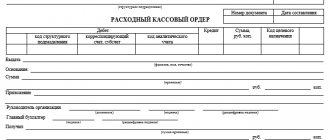Going on vacation followed by voluntary dismissal is an employee’s right enshrined in the Labor Code. To ensure that the labor inspectorate does not have any complaints, the personnel officer and accountant must follow the procedure in strict accordance with the requirements of the law.
Many people prefer to take the opportunity to rest before looking for a new job instead of financial compensation for unused vacation days. However, leave followed by dismissal has a number of features. Let's understand these features, describe how to provide leave with subsequent dismissal, and how to properly draw up the documents. We will answer popular questions on this topic.
How to go on another vacation and quit immediately after it: Art. 127 Labor Code of the Russian Federation
Vacation followed by dismissal is a phrase used in labor legislation as a separate concept.
IMPORTANT! In accordance with Art. 127 of the Labor Code of the Russian Federation, an employee has the right to leave before dismissal (except for dismissal for guilty actions).
This double maneuver by the employee entails additional steps for the employer to formalize and implement it. Each component of the furlough-furlough scheme requires compliance with legal requirements.
For example, dismissal is a whole complex of events, the initial step of which is the employee writing a statement. It launches a mechanism for interaction between management, personnel officers, accountants and other specialists of the company. Each of the listed “cogs” of the internal company apparatus performs its own function, the result of which will be the dismissal of the employee, formalized in accordance with the law.
At the same time, the interests of both parties to the terminated employment contract should not be affected - the employee will receive the money due to him, and the employer will fulfill the functions assigned to him in complying with the dismissal procedure.
“Unified Form No. T-8 - form and sample of completion” will help you fill out an order in connection with the termination of an employment relationship .
No less important in terms of compliance with legally established procedures is the process of an employee going on leave.
This material will help you understand the specifics of issuing a “vacation” order. .
And combining these events into one requires an even more careful and scrupulous approach, since it contains a number of mandatory legal requirements.
ConsultantPlus experts explained whether it is possible to provide a worker with leave at his own expense followed by dismissal. Get free trial access to the system and move on to the Ready-made solution.
Taxes and fees
Compensation paid upon dismissal is not subject to insurance contributions, unlike vacation pay, for which the employer is required to pay insurance contributions.
It turns out that this is beneficial for the employer, he saves on transferring contributions, but it is disadvantageous for the employee, since he pays income tax on this amount, but does not receive any deductions in the form of insurance contributions, and the size of the pension in the future depends on these contributions.
In addition, the amount of sick leave for the next 2 years depends on the amounts transferred to employers in the Social Insurance Fund, and for expectant mothers, transferring to this fund is even more important, since the amount of funds credited there depends on the amount of maternity benefits, as well as child benefits up to 1.5 years.
Application - the starting point for registration
The set of measures to formalize the “vacation-dismissal” procedure begins with an application from the employee. The employee writes it in his own hand in a generally accepted form addressed to the head of the company, indicating his position and surname. There is no special form for such a statement, and there are no restrictions on its volume and content.
Since a double event is planned (vacation - dismissal), there can also be 2 applications. The first will contain a request for leave with a special clause regarding its duration and starting date. The second statement will contain a written desire to sever the employment relationship with the employer.
There is no restriction on the number of statements in the law, so it is possible that the employee will combine the texts of both statements into one document.
If an employee decides to leave immediately after the vacation due to him according to the approved vacation schedule, then a separate application for vacation does not need to be written, since the schedule is already the basis for receiving vacation.
Applications can be made on our website.
Example
Timofeev N.L., an auxiliary worker in the mechanical section, decided to quit, having previously taken his legally earned regular vacation. He considered fiddling with individual applications to be an unnecessary waste of time and effort, so he expressed his will in one phrase: “I ask you to allow me to go on vacation from April 16, 2021 for 28 calendar days, followed by dismissal of my own free will.”
We will tell you how to apply for leave followed by dismissal in the following sections.
Application procedure: how to write and complete an application?
From the provisions of Art. 127 of the Labor Code of the Russian Federation it follows that in order to go on leave with subsequent dismissal, an employee must prepare a corresponding application. We'll tell you how to write it and send it to the recipient.
How to make an application?
The application must be prepared in writing . As of today, there is no single sample application for leave followed by dismissal, so you can use a free form.
In general, when preparing such a document, you should adhere to the following general recommendations:
- the application should be written on A4 paper;
- the text can be written by hand or typed on a computer (the second option is faster and more convenient, so preference should be given to it).
An application for leave with subsequent termination of the employment contract must have the following content:
- First, the “header” of the document is drawn up - it is located in the upper right corner of the sheet of paper. The following information should be provided here:
- Full name and position of the head of the organization, as well as its full name;
- Full name of the employee himself, indicating the position held and the department in which he works.
- Next, the title of the document is placed in the center. Usually the word “Application” is simply written (the applicant can add its decoding if desired).
- The next step is to prepare the main part.
In this section you need to reflect the request for annual paid leave with subsequent dismissal at your own request.You must also include the following information here:
- the exact start date of the vacation;
duration of stay on paid (unpaid) vacation.
- Finally, the date of drawing up the application is indicated, as well as the signature of the employee who wishes to resign.
An employee who intends to resign from his position on his own initiative is not at all obliged to disclose the reason for such a decision. However, you can still specify it if you wish. For example: “...followed by voluntary dismissal due to retirement.”
Application form and example:
When should you write it?
Earlier in the text it was already noted that before leaving at his own request, the employee must work for two weeks . Thus, it can be assumed that an application for leave with subsequent care should be submitted taking into account this period.
However, in view of the fact that the period of being on vacation is counted towards working off, you can submit an application any day before going on vacation. The main thing is that the duration of the requested vacation is at least 14 days. Otherwise, the resigning person will have to work out the remaining term after leaving the vacation.
It is worth keeping in mind that a two-week working period is established for the majority of workers. However, the Labor Code of the Russian Federation identifies certain categories of employees for whom different deadlines for filing such an application apply (for example, according to Article 280 of the Labor Code of the Russian Federation, company managers must notify of their resignation a month before this date).
To whom and how should I submit it?
The current legislation does not stipulate an algorithm for submitting an application for leave with further resignation from the current position.
According to the generally established procedure, the prepared document can be transferred to one of the following persons:
- For HR specialists , this option is relevant when we are talking about a large company with a large staff of employees. In this situation, you should contact only the department authorized to resolve such issues.
- To the head of the organization personally - in the case of a small company in which the functions of a manager, personnel officer, as well as other specialists are solely performed by the head.
Also, certain rules must be followed when submitting an application. It is better to prepare it in two copies:
- the first should be transferred to the HR department or manager;
- keep the second one for yourself, but ask the receiving party to sign the form (in case the document is lost).
If the employer does not want to accept an application for leave with subsequent dismissal, then it should be sent by mail in a certified letter with acknowledgment of receipt. This is necessary to further resolve the situation through regulatory authorities.
Is it possible to withdraw?
Undoubtedly, such a possibility really exists. In labor legislation, the employee has the right to withdraw his application with subsequent reinstatement in his position . However, in order to use it, the following conditions must be met (Part 4 of Article 127 of the Labor Code of the Russian Federation):
- the reason for dismissal must be the personal desire of the employee;
- the application must be withdrawn before the start of the vacation;
- at the time of withdrawal of the application, another employee should not be invited to the vacated place by way of transfer.
Thus, if all three conditions are met, the employee has every chance to continue his work activity. To do this, you need to prepare a new application containing a message about the revocation of the previously submitted one.
We respect rights and take into account restrictions
In order for the procedure for going on leave with subsequent dismissal to be carried out within the framework of labor legislation, the employer and employee must not forget about their rights, responsibilities and restrictions.
Example (continued)
Timofeev N.L., an auxiliary worker at the mechanical section, was refused his desire to go on vacation before his dismissal, and his attempts to complain to the labor inspectorate about his employer were unsuccessful. In this situation, the employer’s consent or refusal is his right, not his obligation, in accordance with the determination of the Constitutional Court of the Russian Federation dated 02/05/2004 No. 29-O.
If the director of the company changes his mind and allows Timofeev N.L. to go on vacation before resigning, Timofeev N.L. has a chance to change his mind and not sever the employment relationship.
There is one exception to this rule: it will not be possible to refuse leave before dismissal if a clause on the provision of leave before dismissal is present in the agreement between the employee and the company (employment contract).
Legislation allows an employee to express his desire to return to his workplace after a vacation, but there is a time limit for such a step: he can change his mind only before going on vacation (letter of Rostrud dated December 24, 2007 No. 5277-6-1, ruling of the Constitutional Court dated January 25 .2007 No. 131-О-О).
The next point that requires attention is the legal ban on the “vacation-dismissal” event for a certain category of employees.
Example (continued)
A colleague of the auxiliary worker Timofeev N.L., a truant and rowdy mechanic Gulyaev I.T., who was dismissed under an article for malicious violation of labor discipline, decided, following the example of his friend, to write an application for leave with subsequent dismissal. But the employer refused. According to Art. 127 of the Labor Code of the Russian Federation, malicious violators of labor discipline and those dismissed for this reason do not have the right to leave before dismissal.
The above legislative nuances must be taken into account by both the employee (before writing an application) and the employer (when considering this application).
Is it possible to withdraw a resignation letter?
The reason for the employee to first be given leave and then to be dismissed is the application he has drawn up. In practice, an employee is sometimes asked to write two separate applications - one for leave, the second for dismissal. But it is also possible to combine both requests into one form.
Since the employee draws up a resignation letter at his own request, the law allows for the possibility of its withdrawal. However, if leave of absence is requested, there is one caveat associated with the recall.
The actual date of termination of the relationship between the company and the employee in case of such dismissal will be considered the final day of vacation, and the last day at work will be the day before the vacation is granted.
If an employee has requested leave with further dismissal, then he can change his mind about terminating the contract only until he goes on vacation. This is due to the fact that on his final day of work, the employee receives both settlement money and all required documents.
You might be interested in:
Limitation period for labor disputes, their types, features of consideration in court
Thus, during the vacation period, although the employee is still an employee of the company, his dismissal has already been registered. It is no longer possible to undo this.
Attention! Therefore, if an employee wants to return, and the manager does not object to this, it is necessary to wait until the end of the rest period, and then go through the registration procedure with the company again.
Date of dismissal after vacation: an important aspect
In a “vacation-dismissal” situation, the dates of the last working day and dismissal do not coincide.
In accordance with Art. 84.1 of the Labor Code of the Russian Federation, the day of dismissal (termination of an employment contract) is the last working day of an employee with a given employer. This is the general approach. However, in the situation of going on vacation with subsequent dismissal, the date of dismissal is considered the last day of vacation (Article 127 of the Labor Code of the Russian Federation). And the last working day is the last day the employee goes to work (determination of the Constitutional Court of the Russian Federation dated January 25, 2007 No. 131-О-О).
IMPORTANT! It is necessary to make a final settlement with the employee and issue a work book on the last day of his work before the vacation.
At the same time, from the norms of labor legislation described above, it follows that the dismissal in the work book and order is dated by the last day of the employee’s vacation.
The date of dismissal (as well as the vacation itself) are not postponed if the employee who went on vacation gets sick. The employer has no obligation to extend the rest period for the employee's sick days, despite the general rule prescribed in Art. 124 of the Labor Code of the Russian Federation, since with the start of vacation the employment relationship is considered severed (letter of Rostrud dated December 24, 2007 No. 5277-6-1).
What if an employee gets sick on vacation?
An employee of an enterprise who has a rest period with further dismissal may experience a period of incapacity during this period.
Legislation under normal conditions determines that sick days not only must be paid, but also extend the period of rest provided. However, when taking a vacation with further termination of the contract, different rules apply.
Sick leave provided by the resigning employee is also fully paid. But time off work does not increase the number of vacation days.
Because the administration has at its disposal the expiration date of the contract, the necessary forms have been completed, and the money has been paid. That is, the entire termination procedure has been completed and cannot be cancelled.
Choosing the form of an order for leave with subsequent dismissal
Taking into account the above, having received an application from the employee, the employer will have to issue an order - a local internal act related to the “vacation - dismissal” procedure (Article 84.1 of the Labor Code of the Russian Federation). He also has the right to choose: to order leave and dismissal in one document or to issue 2 orders separately for each part of the “vacation-dismissal” event.
With the first registration option, it will be necessary to issue an order in a independently developed form and provide for the entire scheme in full: granting leave and subsequent termination of the employment contract.
The second option will not require unnecessary actions from the employer - it is enough to fill out the usual unified forms of “vacation” order (T-6, T-6a) and “dismissal” (T-8, T-8a).
IMPORTANT! The formats of documents used by the company (both unified and created in-house) must be approved by the manager and developed taking into account the recommendations of GOST R 15489-1-2007 “Document Management”.
For information on mandatory personnel documents and personnel records, see the material “Personnel documents that must be in the organization .
Benefits of the application
This form of application gives obvious preferences to the employee who has decided to resign. The main thing is the time that he gains to look for a new job without losing his seniority and without having to work the required two weeks. For the employer, there are fewer advantages in this situation, but they also exist - the law is followed, more time remains to find a new employee, and good relations with the former subordinate are maintained.
- Form and sample
- Free download
- Online viewing
- Expert tested
FILES
Sample order for leave with subsequent dismissal at will
Dismissal after vacation is formalized by an order containing 3 main components: introductory part, main text and final elements.
The introductory part of the order contains 2 names: the name of the company (this attribute is required for any internal document) and the title of the order. It may sound like this: “On granting leave with subsequent dismissal.”
The listed elements are supplemented by the order number and its date.
The main text of this document should reflect all the necessary components of the “vacation-dismissal” procedure. Namely: order the provision of leave to the employee (indicating its starting date and duration) and provide for the termination of the employment contract after its end (indicating the details of the contract itself and the date of dismissal).
An integral element of the main text of the order is the instruction from the management to the involved services (HR and accounting) to pay the employee and take care of issuing him a set of “dismissal” papers.
The material “Unified Form No. TD-1 - Employment Contract” .
An example of the design of the main part of the text of an order regulating the stages of dismissal after voluntary leave:
1. Provide mechanic Khusnutdinov P.N. with leave followed by dismissal from November 3 to November 30, 2021, lasting 28 calendar days.
2. Terminate the employment contract dated February 12, 2018 No. 134 with Khusnutdinov P.N. on the basis of clause 3 of Art. 77 Labor Code of the Russian Federation. The day of dismissal is considered to be November 30, 2020.
3. The head of the financial and accounting group, Kamaletdinova R.R., make the final settlement with Khusnutdinov P.N.
4. The head of the personnel department, Aidarov N.G., issue Khusnutdinov P.N. with a work book and other documents provided for by labor legislation, 11/02/2020.
ATTENTION! If you keep work books in electronic form, upon dismissal the employee must be given an electronic version of his work record in the STD-R form. How to fill out the form correctly, see here.
The final elements of the order are a reference to the basis for its execution (Articles 77, 84.1, 127 of the Labor Code of the Russian Federation, personal statement of the employee, etc.) and the signature of the head of the company. An employee going on vacation with subsequent dismissal is familiarized with the order, which he also signs.
How to make an entry in the work book if an employee is granted leave with subsequent dismissal? Find out the answer to this and other questions by getting a free trial access to the ConsultantPlus system.
Is it possible to fire an employee while he is on vacation?
This possibility depends on the grounds for dismissal and who initiates it. If dismissal occurs on the initiative of the employee (at his own request) or by agreement of the parties, this option is possible. Thus, employees who leave voluntarily have the right to use this option in order to avoid the two-week work period required in such cases. However, there is plenty of room for creativity here too. The employee is required by law to notify of his decision two weeks before the desired date of dismissal. But the employer has the right to fire him earlier if he does not object. Including during vacation.
The Labor Code of the Russian Federation allows for the option of granting leave with subsequent dismissal
As for the agreement of the parties, here the law opens up complete freedom of action, the only limitation of which is the mutual consent of the employee and the employer to the terms of dismissal, including its terms.
At the beginning of the 2000s, the author of these lines decided to resign of his own free will on the eve of his vacation, the order for which had already been signed. The HR manager had doubts about whether it was possible to fire me during my vacation. As a result, the order and the entry in the work book were dated the first working day after it. However, this option suited me. At the new job, they didn’t see a big problem in the fact that I would enter my work book two weeks later. And the accounting department at the old one didn’t have to recalculate the vacation pay already given to me. We can also add that this story happened even before the adoption of the current Labor Code of the Russian Federation. The version of labor legislation in force as of 2018 fully allows for the option of dismissal at will during vacation.
As for recalling an employee from vacation, including for dismissal, this aspect of labor relations itself represents a separate topic that deserves special consideration. And in relation to the situation under consideration, we can only say that an exhaustive list of reasons for this is listed in Art. 79 of the Labor Code of the Russian Federation, and dismissal is not on this list. The reasons prescribed there are mainly of an emergency nature (for example, preventing an accident or natural disaster at work or eliminating the consequences of what has already happened), are related to the performance of work duties, and not their termination, and require the consent of the employee, who has the right to refuse. And the employer has no legal leverage in case of refusal.
Dismissal during vacation, including educational or maternity leave, at the initiative of the employer is possible only upon liquidation of the organization. In this case, he is obliged to warn the employee two months in advance. And inviting him to work for this is quite acceptable. Although there is another option - send a written warning to the employee’s home address or place of temporary residence, if known. It is understood that notice sent by mail must be accompanied by a return receipt. And the date of familiarization of the dismissed person with the warning will be considered the day specified in this notice.
Several years ago in Kyzyl, an employee of the local branch of Russian Post, who was on maternity leave, was called to the personnel department two months before his intended dismissal and informed of the impending reduction of his position. He was fired on the first day after the end of his vacation. Subsequently, in court, he managed to prove that he had been deceived: the personnel department convinced him to sign the papers under the pretext that it was just a formality. And only at home he became convinced that, it turns out, he had agreed to the dismissal not due to a reduction in staff, which was initially discussed, but by agreement of the parties without payment of compensation due for the reduction. He managed to convince the court of this. But the form of notice of dismissal with an invitation to the HR department during vacation did not cause any complaints either from the plaintiff himself or from the court.
Providing leave with subsequent dismissal: the stage of processing payments
An integral part of the “vacation-dismissal” event is the settlement stage. Since the employee not only goes on vacation, but also quits immediately, it is necessary to take into account both types of payments: those related to both the vacation and the final payment.
The executed order, which was described in the previous sections, serves as the basis for issuing a settlement note. If a company has established by its internal local act the use of unified forms in its work, it will have to complete 2 calculations:
- T-60 “Note-calculation on granting leave to an employee” is filled in with information about the billing period and earnings for the specified period. The average daily earnings, calculated in accordance with the Government Decree on the procedure for calculating the average salary dated December 24, 2007 No. 922, is multiplied by the number of vacation days. As a result, the amount of vacation pay is formed.
The sample posted on our website in the material “Unified Form No. T-60 - Form and Sample” .
- T-61. “Note-calculation upon termination (termination) of an employment contract with an employee (dismissal)” is drawn up as follows:
- on the front side of the form information about the employee (full name, position) and details of the dismissal order are reflected, and a note is made that the employee did not take full leave or used it in advance;
- on the reverse side of the form, the billing period and earnings for the months of this period are indicated, then the average daily earnings are calculated and the amount of compensation for the part of the vacation not taken off.
IMPORTANT! Compensation is calculated taking into account the payments provided by the company - clause 2 of Resolution No. 922 contains their full list. In this case, individual payments listed in paragraph 5 of Resolution No. 922 are not taken into account.
For the completed version of Order T-61, see the material “Unified Form No. T-61 - Form and Sample” .
We will tell you more about how to calculate “vacation” compensation and in what cases you can do without this calculation in the following sections.
Is it possible to dismiss an employee on the last day of vacation without his application?
Any employer initiatives without the knowledge or consent of the employee will be considered illegal. Excluding options with deliberate deception of employees, the employer should still support the oral statement of the hired specialist with written confirmation.
In the event that an employee himself wishes to terminate cooperation after the end of his vacation, management must proceed as follows:
- Record the employee’s initiative on paper, even if the relationship with him remains unspoiled.
- In the dismissal order, indicate the end date of the vacation if the resignation was announced before it was formalized.
- If the application was submitted after the start of the vacation, then the calculation must be made on the first day after the end of the vacation period.
Formally, this last day (according to the schedule) will be considered full work.
Calculation of vacation compensation
In a situation where an employee goes on vacation and is subsequently fired, compensation for unpaid vacation days is not always calculated. There is no need for calculation if the employee has taken all vacation periods in full.
However, often workers are not allowed to fully rest due to production needs, or the reduced vacation is due to the desire of the employee himself. Then, before dismissal, the employer needs to calculate and pay “vacation” compensation. Its value depends on the number of unused vacation days and average daily earnings.
For information on the specifics of calculating vacation days not taken off, see the material “How to calculate the number of vacation days upon dismissal?” .
The calculation of “vacation” compensation is made not only by the number of vacation days not taken in the current year, but also taking into account the duration of all vacations not used by the date of dismissal. For example, for the last 3 years, an employee has only had 14 of the required 28 days of rest, but this year he earned 20 days of vacation, of which he used only half. By summing up the indicated non-vacation days, we get the number 52 (14 × 3 + 20 / 2) - it must be multiplied by the average daily earnings to determine the amount of “vacation” compensation.
Read more about calculating compensation for unused vacation here .
By agreement of the parties
On the last day of vacation, an employee can be dismissed by agreement with the employer (Article 78 of the Labor Code of the Russian Federation).
Unlike leaving voluntarily, such dismissal can be done in one day . That is, on the last day of vacation, the employee and the employer sign an agreement that includes the terms of dismissal, payments, etc., and the next day, which should have been the employee’s working day, he no longer goes to work.
Important! To carry out such termination of the contract, it is necessary that one of the parties sends a dismissal proposal to the other the day before the last day of vacation.
The proposal can be written (including in the format of an electronic document) or oral in front of witnesses.
After negotiations (it can also be carried out remotely, using audio or video communications), the parties sign an agreement. To do this, the employee will still have to come to work if it is not possible to sign a digital signature.
Unlike a statement, an agreement between the parties cannot be revoked.
Final settlement
In addition to determining the amount of “vacation” compensation, it is necessary to make a number of calculations and calculations. It all depends on the terms of the employment contract or agreement on its termination, as well as the presence in the company’s internal local acts of reference to compensation, severance pay or other “dismissal” payments.
First of all, you will need to calculate the salary for the days worked, and then make all the necessary deductions to obtain the final settlement amount issued to the employee in connection with his dismissal.
How to calculate salary upon dismissal, read here.
In addition, it is necessary to take into account that labor legislation protects the interests of the employee in a situation of dismissal, providing for the need to pay severance pay.
IMPORTANT! If an employee resigns due to the closure of a company or staff reduction, Art. 178 of the Labor Code of the Russian Federation obliges the employer to pay him severance pay in the amount of the average monthly salary. Find out how to calculate the amount of severance pay here . In addition, this article provides for cases of maintaining the employee’s average monthly earnings during the second (if he brings evidence that he is not yet employed) and third (by decision of the employment service) months after dismissal.
In some cases (for example, an employee is called up for military service), severance pay will have to be paid in the amount of two weeks' average earnings (Articles 77, 83, 178 of the Labor Code of the Russian Federation).
When making a final settlement with a resigning employee, it is necessary to take into account all benefits and compensations due to him (both under labor legislation and those provided for in the employment contract and internal company regulations).
For other reasons
These include:
- expiration of the temporary contract or departure of the main employee;
- termination of the contract due to exceptional circumstances (for example, complete disability of the employee).
If the contract expires, the employer notifies the employee 3 days in advance (Article 79 of the Labor Code of the Russian Federation), while when the main employee returns, the temporary one can be notified 1 day in advance, having studied the Order of his dismissal.
Dismissal due to circumstances beyond the control of the parties (Article 83 of the Labor Code of the Russian Federation) is formalized within one day.
Taking leave followed by dismissal: the final stage
Paying an employee is an important, but not the last step in the multi-stage “vacation - dismissal” event. Without additionally filling out the paperwork, it will not be possible to say goodbye to the employee.
The first important and mandatory document issued to any resigning employee (in addition to the work book), even if he did not ask for it, is a certificate of earnings for the two calendar years preceding the dismissal .
IMPORTANT! A certificate of earnings is issued to the employee in the form approved. by order of the Ministry of Labor dated April 30, 2013 No. 182n (Clause 3, Part 2, Article 4.1 of the Law “On Compulsory Social Insurance” dated December 29, 2006, No. 255-FZ). The procedure for filling out such a certificate can be found here.
Other mandatory documents to be issued to employees upon termination of employment are (Clause 4, Article 11 of the Law “On Personalized Accounting” dated 04/01/1996 No. 27-FZ):
- an extract from SZV-M for the month in which the employee quits;
- SZV-EXPERIENCE for the person resigning (for the year of dismissal);
- Section 3 of the unified calculation of insurance premiums for the quarter in which the employee is dismissed.
Usually, contacts with the resigning employee do not end there - the employee can contact the company’s specialists with a request to provide additional certificates and copies of documents. At the same time, the issuance of papers cannot be carried out uncontrolled according to the “asked and received” scheme. Communication between a resigning or already resigned employee and a former employer is based on an algorithm (Article 84.1 of the Labor Code of the Russian Federation).
This rule applies to the employee’s desire to obtain certificates (Article 62 of the Labor Code of the Russian Federation):
- on accrued and paid insurance pension contributions;
- period of work in this company;
- income in form 2-NDFL (the procedure for issuing it is described here ).
In addition to the specified papers, the employee has the right to request the necessary information about his transfers in the course of his work in this company, copies of orders for hiring and dismissal - the employer has no right to refuse this request. The employee is not obliged to pay money for the copies received (Article 62 of the Labor Code of the Russian Federation, letter of Rostrud dated December 20, 2012 No. PG/9518-6-1).
Basic procedure for granting leave
The rules for granting vacations are fixed in the Labor Code of the Russian Federation. The law provides for the following types:
- Paid leave granted to an employee annually (Article 114). It can be primary or additional.
- Leave granted without maintaining basic earnings (Article 128).
- Leave granted to women for pregnancy and childbirth (Article 255).
- Leave for training (Articles 173-176).
According to labor legislation, every employee who has worked at the enterprise for more than six months acquires the right to paid leave. If the parties agree, a citizen may be sent on leave before the expiration of the specified period. For the following categories, this condition is mandatory:
- Persons under the age of majority.
- Women who have reached the deadline for receiving maternity leave.
- Employees who have registered the adoption of a child under 3 years of age.
- Other categories, if provided for by federal laws.
The employer is required to provide vacation annually. There are two types:
- Additional.
- Basic.
The following categories of citizens can apply for additional leave:
- Persons working in hazardous and hazardous industries.
- Citizens who have irregular working hours.
- Workers carrying out labor activities in the regions of the Far North and regions equivalent to them.
- Employees whose working conditions are recognized as special.
The minimum period that employees can claim when receiving basic leave is a period of 28 calendar days. Its maximum is not limited by the Labor Code (Article 122).
The following is counted as length of service, which entitles a citizen to receive basic leave:
- The period during which the person performed his direct labor duties.
- The time period during which a citizen did not work, but according to the law retained his position and the prescribed salary (for example, weekends and holidays, etc.).
- The period during which the employee was forced not to appear at the workplace due to the employer’s illegal actions against him (for example, due to illegal dismissal).
- The time period when the employee was suspended from performing his work duties by the medical commission, but his fault was not considered.
- The period during which the citizen was on unpaid leave of his own free will, if it did not exceed 2 weeks.
Results
The procedure for registering leave with subsequent dismissal is initiated by the employee’s application, followed by orders for leave and termination of the employment contract.
An integral stage of this event is the calculation of “vacation” compensation and other payments and deductions. The process is completed by issuing the resigning employee a set of documents (work book, certificates, etc.).
Sources: Labor Code of the Russian Federation
You can find more complete information on the topic in ConsultantPlus. Free trial access to the system for 2 days.
Procedure
To comply with the dismissal procedure and prepare all documents, you must follow a certain algorithm:
- the employee draws up a letter of resignation in writing and submits it to the manager for review;
- the employer signs the application and submits it to the HR department. After which he issues an order to grant the employee leave;
- the order is registered in the relevant documents and submitted to the employee for review and signature;
- a settlement note is drawn up;
- an order is issued to terminate the employment relationship with the employee;
- the order is registered in the accounting journal and handed over to the employee for review and signature;
- compensation is calculated, all monetary payments due to the employee are issued;
- a record of dismissal is left in the employment record;
- Employees are given all the necessary documents.
It is important to know! If an employee’s vacation ends on a day off, the manager is obliged to carry out the dismissal procedure on the next working day. It is then that the order is issued, funds and documents are issued.
How to calculate compensation for unused days?
If by the day the employment relationship is terminated the employee has not had time to use the rest days allotted to him, then the employer is obliged to compensate them in cash. The calculation formula is:
- We calculate the number of days of rest that are due per month of work.
To do this, you need to divide the number of vacation days by 12 (the number of months in a year). For example: an employee has the right to 36 days of vacation, which means he is entitled to (36/12) 3 days of rest per month. - We calculate the total number of months worked. For example: an employee worked for 7 months and 18 days. Since 18 days are more than half a month, the number of months worked here should be rounded to 8.
- We get the number of vacation days subject to compensation: 3 x 8 = 24 days.
- We calculate compensation in monetary form: we multiply the number of paid days of unused vacation by the employee’s average daily earnings. For example: the average daily salary is 1,600, which means the amount of vacation pay will be 38,400 rubles.
Rest in advance and termination of an employment contract: is work required?
In civil organizations and the Labor Code there is no such concept as “vacation in the year of dismissal”. But often it is understood as the situation of advance leave (leave on account of the next year), which is completely different from military leave.
An employee who has worked in an organization for more than 1 year is given vacation according to a schedule, and it often turns out that he gets his vacation in advance, that is, for the next year.
If he decides to quit during or after his vacation, he should prepare to pay compensation to the employer.
If the employee does not want to voluntarily reimburse the amount, the employer can withhold it, but in the amount of no more than 20% of the salary (Part 1 of Article 138 of the Labor Code of the Russian Federation).
The same amount applies to the calculation of payments due upon dismissal, which is confirmed by both judicial practice and clarifications of Rostrud.
In such cases, the organization’s accounting department is required to:
- calculate the number of vacation days not worked by the employee;
- calculate the amount of money for unworked vacation days;
- adjust reporting documents, including tax reports.
The voluntary dismissal procedure itself will not have any special features: the employee will be required to apply and work for two weeks (not to work off vacation pay, but as a general rule), but a certain amount will be withheld from him upon settlement.
Terms of service
The Labor Code of the Russian Federation identifies several types of leave that an employer can provide:
- annual;
- additional paid;
- additional, which the employee can take at his own expense.
Only employees who have worked continuously in the company for more than six months can take advantage of the right to receive vacation; otherwise, vacation is compensated by payment of a sum of money. There are categories of citizens who should be provided with rest without reaching the specified period:
- minor workers;
- women whose pregnancy was confirmed by relevant documents;
- people who care for a child under three years of age.
At the same time, at the legislative level the possibility of receiving any type of leave with subsequent termination of the employment contract is not excluded. To do this, several conditions must be met:
- obtain the consent of the head of the company.
It is important to know! Article 127 gives the manager the right to grant an employee leave with subsequent dismissal, but does not oblige him, which allows the employer to make decisions independently.
- have in reserve one unused vacation for the previous period or the current year. It is worth noting that for each month a person receives 2.33 days of vacation.
This right is deprived of citizens whose dismissal is carried out due to guilty actions or violation of labor laws, for example:
- absenteeism;
- neglect or improper performance of official duties;
- violations that caused damage to the company;
- immoral behavior or being intoxicated at work.
If a refusal is received from the employer, the employee is paid monetary compensation for the leave that was not used.
Read on the topic: Continuous service after dismissal at will
Read on the topic: Dismissal of an employee at his own request without working for two weeks



